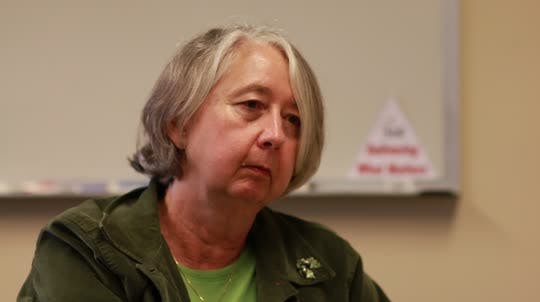The picture of Desi Irving, a smiling 3-year-old girl in a bonnet and braids, is as vivid to Jane Ranum now as when she first saw it in 1997.
Desi's death at the hands of her abusive mother made the toddler the face of a failing child-protection system. As a state senator, Ranum championed a new approach that she hoped would prevent another death like Desi's.
Seventeen years later, Ranum's memories of Desi have turned to feelings of anger and betrayal. Now a district judge for Hennepin County, she blames the current breakdowns of child protection on the very program she helped create.
That program, called "family assessment," has become the main method for protecting Minnesota's children. Rather than investigate and punish a child abuser, social workers offer services intended to strengthen families and keep them together.
Ranum and other lawmakers intended this softer approach for less serious cases of abuse and neglect. State law mandates investigation for cases of egregious harm and substantial endangerment.
Yet more than 20,000 cases of children deemed at "high risk" for more abuse have been routed to family assessment since 2005, records show.
A Star Tribune review of more than 400 child abuse cases found family assessment was used after children were reported to have been severely physically and sexually abused or abandoned. The review showed that dozens of children were later harmed, including at least 27 who were killed.
"I am sickened by how it's being used," Ranum said of the family assessment program. "It was never meant for the types of abuse and severe neglect cases it is being used for now."
As family assessment has grown, child-protection agencies have moved away from investigating abuse. Counties investigated only 7 percent of abuse reports made in Minnesota last year. They "screened out" 71 percent of them, meaning they didn't provide child-protection services. That's one of the highest rates in the country. The rest went to family assessment.
While more than half the states in the country now use a form of family assessment, researchers say only one may be using it for high-risk cases: Minnesota.
Among those cases was 4-year-old Eric Dean, who was reported to Pope County child protection 15 times before he was murdered by his stepmother in February 2013. Three of those reports were routed to family assessment, while only one was investigated. The rest were screened out. Eric's case, detailed in a Star Tribune report in August, prompted Gov. Mark Dayton to create a task force charged with recommending changes to the child-protection system — much as Desi's case did 17 years ago. The task force convenes Monday morning.
Even as some researchers now question the family assessment model, county social service directors and leaders at the Department of Human Services (DHS) contend that it is a safe and effective response to child abuse. With the threat of punishment removed, supporters of the approach say parents are more likely to work with social workers.
DHS recently began to study how well family assessment works, and the impact of putting high-risk kids into the program, said Erin Sullivan Sutton, the department's assistant commissioner for children and family services.
"If the system has gone too far, then we should take a look at it," she said.
But, Sullivan Sutton said, it's a mistake to think child protection was a success before the advent of family assessment.
Ranum's turnaround on family assessment stems from seeing the troubled families who end up in her courtroom. Since becoming a family court judge in 2010, Ranum said she's seen countless abuse reports go uninvestigated, families repeatedly offered services that they reject, and parents not held accountable for hurting their children.
"Parents are getting the message that what they're doing is OK," Ranum said. "Kids are slowly being neglected to death. ... The system is worse than it ever was."
Girl's death prompted change
That system has its origins in the outrage over the death of Desi Irving, who lived in Ranum's Minneapolis Senate district. The girl was abandoned by her mother, and later returned to her mother's custody by county child protection. That case prompted a Legislative Auditor report, which suggested the state look at alternative programs that offered a less adversarial response to families, particularly those accused of neglecting their kids.
"These are often people that distrust the government. They hate to cooperate," Ranum said. "Instead of just investigating, the idea was to use resources to provide services to these families to keep them from going deeper into the system.
"It was meant as a diversion for one-time offenders," she said.
The program could include giving money to parents to pay for transportation, rent, phone or day-care bills, Sullivan Sutton said, in the hope that they would treat their children better.
Ranum, then a state senator who focused on child welfare issues, said she was skeptical at first. She embraced the idea after she and 19 other Minnesota policymakers went to Missouri, where social workers said their "alternative response" saved money on investigations and helped low-risk families.
As chair of the Senate Judiciary Committee, Ranum held hearings and worked with Sullivan Sutton on how the program would be rolled out. The Legislature voted overwhelmingly in favor of Ranum's bill to institute family assessment on a pilot basis. In 2000, 20 counties began offering family assessments.
The Legislature also wanted a study of the program. The Institute of Applied Research, a Missouri-based independent nonprofit, studied 7,784 families in 14 of the 20 Minnesota counties from February 2001 to December 2002. The conclusion, reported in 2004: Families responded more positively to social workers, and the "safety status" of children improved.
Even before the institute released its results, every county in Minnesota was using family assessment. It offered an alternative to social workers who before only had the option of punishing parents, said Judith Brumfield, the director of Scott County Health and Human Services. And the ultimate punishment, removing children from their homes, can be just as traumatizing as leaving them with an abusive parent, she said.
"I've learned the only way of saving children is through saving their family," Brumfield said.
At DHS's urging, state Sen. Becky Lourey in 2005 sponsored a bill that set up two tracks for child protection to act on credible abuse reports in Minnesota. It proposed that cases of substantial child endangerment and egregious harm should be investigated within 24 hours. Anything else should go to family assessment, where social workers have five days to respond.
The bill passed unanimously and was signed into law by Gov. Tim Pawlenty in June 2006.
Lourey said the bill was intended for "the least serious of cases."
For county child-protection agencies, however, the retreat from investigating child abuse had already gone much further.
'There must be a mistake'
As Minnesota's child-protection approach evolved, the system continued to fail children whose names never reverberated like Desi Irving's. One of them was Lakesha Victor, a 10-year-old girl who had cerebral palsy, autism and a seizure disorder. Lakesha was found starved to death in 2006 in her Pine County home.
Despite her mother's previous run-ins with child protection in Texas and Nevada, Pine County opened a family assessment case on Lakesha in November 2004, and the next year assessed the child as safe.
That case was one of three child abuse deaths that year in which caretakers were previously offered family assessments, the Star Tribune found.
After the 2006 session, Ranum retired from the Legislature. In 2009, she was elected to the Hennepin County bench, and the next year was appointed to family court.
By that time, counties were using family assessment for two-thirds of their child-protection responses.
From her sixth-floor courtroom in downtown Minneapolis, Ranum began presiding over custody and order-for-protection cases involving severe and repeated child maltreatment that child protection would not investigate.
"I thought there must be a mistake," she said. "I began to realize that family assessment was being used for these kinds of cases."
She said those cases would traditionally be handled as child-protection matters in juvenile court. Those judges can order county child-protection agencies and parents to take actions that would keep kids safe, such as putting children in foster care. Family court judges do not have that authority.
She said she reported the abuse cases to Hennepin County, then was crestfallen to see the cases either closed with no action, or referred to family assessment.
Ranum met with county child-protection workers about the use of family assessment, but said she was consistently told that DHS wanted to increase the use of the program.
Greg Gardner, who worked for Hennepin County child protection from 1977 until he retired in March as an investigation supervisor, said DHS was continually pushing the county to steer 70 percent of accepted cases into family assessment. Gardner said he would not put high-risk abuse cases into family assessment for the team he managed because that's "not what it was designed for."
Sullivan Sutton of DHS said her agency has never pressured counties to increase the use of family assessments. "We say if your county is at one extreme or the other, in terms of the others, you might want to take a look at it," she said.
The only data the state has on the effectiveness of family assessments show the rate of re-reports higher for those cases than investigations. About 17 percent of children who went through family assessments were reported again for abuse within a year, compared with 14 percent who went through investigations.
University of Minnesota child development Prof. Canan Karatekin noted the rapid rise of family assessment and wanted to see how it worked for kids. She was dismayed: The state had no data on outcomes.
Nevertheless, family assessment has been embraced well beyond Minnesota. More than half the states are using family assessment, according to the Kempe Center, a Colorado organization that studies child protection.
That growth, said Lisa Merkel-Holguin, a Kempe pediatrics professor, can be traced to the 2004 Missouri study done by the Institute of Applied Research, along with a follow-up study released in 2006, which she called the "gold standard" for child-protection research.
Merkel-Holguin said most states use family assessment for only low- to moderate-risk cases, and Minnesota "is probably the only state that has accepted high-risk cases" into the program.
In September 2013, the North American Resource Center for Child Welfare released the first-known study on family assessment's impact across the country. The lead author of that study, Ron Hughes, called the Institute of Applied Research studies "fundamentally flawed." Hughes said he believes family assessment can be dangerous for children because families can close cases merely by rejecting services.
Anthony Loman of the Institute of Applied Research says his research is sound. Besides, "where are the studies showing that an investigation makes children safer?" he said.
'So damaged'
As the child abuse task force created by Gov. Dayton in the wake of Eric Dean's death is set to convene Monday, Ranum hopes history doesn't repeat itself — again.
Three family assessments were opened for Eric. Two of them followed reports that he had bite marks and bruises covering his face. In both of those cases, his father and stepmother refused services. The stepmother, Amanda Peltier, is serving a life sentence for murder.
Ranum said the task force has an opportunity to refocus child protection on what's best for children, not parents, and end the cycle of abuse that she witnesses in her courtroom.
"Some of these children are so damaged now that they might never be able to recover," she said. "It doesn't have to be this way. These kids can be saved."
Brandon Stahl • 612-673-4626

Trail section at one of Minnesota's most iconic spots closing for rehab

Will 'shotgun only' zone for deer in southern Minnesota be abolished?

Four Minnesotans catch salmonella in outbreak linked to basil sold at Trader Joe's


